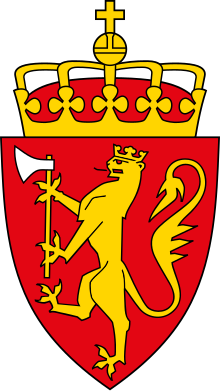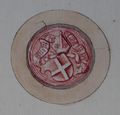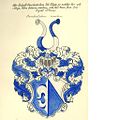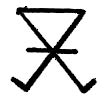
In British heraldry, a coronet is any crown whose bearer is less than sovereign or royal in rank, irrespective of the crown's appearance. In other languages, this distinction is not made, and usually the same word for crown is used irrespective of rank In this use, the English coronet is a purely technical term for all heraldic images of crowns not used by a sovereign, and implies nothing about the actual shape of the crown depicted. A Coronet is another type of crown, but is reserved for the lower ranks of nobility like Marquesses and Marchionesses, Earls and Countesses, Barons and Baronesses, and some Lords and Ladies. The specific design and attributes of the crown or coronet signifies the hierarchy and ranking of its owner.

Nobile is an Italian hereditary title borne by a noble who ranks similarly or just below a baron, similar to the rank of Baronet in England, Fidalgo in Portugal or Ritter in Germany. Unlike higher Italian titles which are typically referred to in lieu of an individual's name, nobile is used immediately before the given and surnames, usually in the abbreviated form Nob..
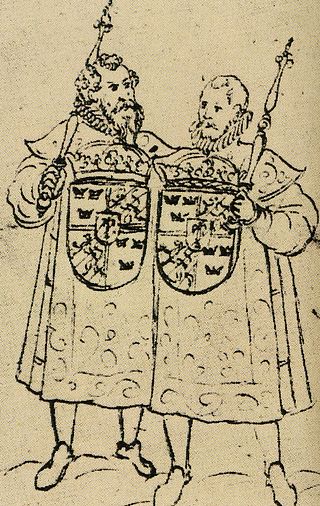
Swedish heraldry encompasses heraldic achievements in modern and historic Sweden. Swedish heraldic style is consistent with the German-Nordic heraldic tradition, noted for its multiple helmets and crests which are treated as inseparable from the shield, its repetition of colours and charges between the shield and the crest, and its scant use of heraldic furs. Because the medieval history of the Nordic countries was so closely related, their heraldic individuality developed rather late. Swedish and Finnish heraldry have a shared history prior to the Diet of Porvoo in 1809; these, together with Danish heraldry, were heavily influenced by German heraldry. Unlike the highly stylized and macaronic language of English blazon, Swedish heraldry is described in plain language, using only Swedish terminology.
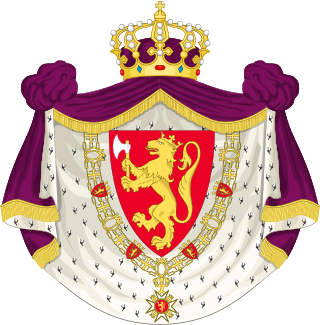
The coat of arms of Norway is the arms of dominion of king Harald V of Norway, and as such represents both the monarch and the kingdom. It depicts a standing golden lion on a red background, bearing a golden crown and axe with silver blade.
The aristocracy of Norway is the modern and medieval aristocracy in Norway. Additionally, there have been economical, political, and military elites that—relating to the main lines of Norway's history—are generally accepted as nominal predecessors of the aforementioned. Since the 16th century, modern aristocracy is known as nobility.

The law of heraldic arms governs the "bearing of arms", that is, the possession, use or display of arms, also called coats of arms, coat armour or armorial bearings. Although it is believed that the original function of coats of arms was to enable knights to identify each other on the battlefield, they soon acquired wider, more decorative uses. They are still widely used today by countries, public and private institutions and by individuals. The earliest writer on the law of arms was Bartolus de Saxoferrato. The officials who administer these matters are called pursuivants, heralds, or kings of arms. The law of arms is part of the law in countries which regulate heraldry, although not part of common law in England and in countries whose laws derive from English law.

Portuguese heraldry encompasses the modern and historic traditions of heraldry in Portugal and the Portuguese Empire. Portuguese heraldry is part of the larger Iberian tradition of heraldry, one of the major schools of heraldic tradition, and grants coats of arms to individuals, cities, Portuguese colonies, and other institutions. Heraldry has been practiced in Portugal at least since the 12th century, however it only became standardized and popularized in the 16th century, during the reign of King Manuel I of Portugal, who created the first heraldic ordinances in the country. Like in other Iberian heraldic traditions, the use of quartering and augmentations of honor is highly representative of Portuguese heraldry, but unlike in any other Iberian traditions, the use of heraldic crests is highly popular.

A crown is often an emblem of a sovereign state, usually a monarchy, but also used by some republics.

The coat of arms of Trondheim is based on the medieval seal of the city. The seal is probably from the 13th century, but its earliest preserved form is on a document from 1344. The coat of arms was assumed by the city council in 1897, and has a more intricate design than most other Norwegian coats of arms.
Danish heraldry has its roots in medieval times when coats of arms first appeared in Europe. Danish heraldry is a branch of the German-Nordic heraldic tradition.

Burgher arms or bourgeois arms are coats of arms borne by persons of the burgher social class of Europe since the Middle Ages. By definition, however, the term is alien to British heraldry, which follows other rules.
Finnish heraldry has a common past with Swedish heraldry until 1809 and it belongs to German heraldric tradition.
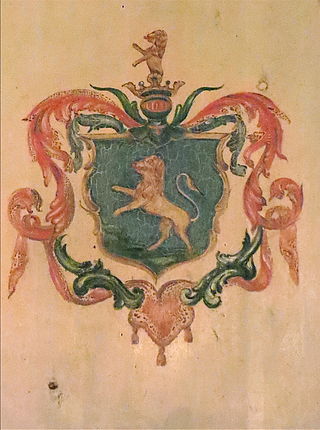
The Løvenskiold family is a Dano-Norwegian noble family of German origin. Members of the family now live primarily in Norway. Originally named Leopoldus, it was one of the early patrician Norwegian families to buy noble status, in 1739, when it was also granted the surname Løvenskiold.

The study of Dutch heraldry focuses on the use of coats of arms and other insignia in the country of the Netherlands. Dutch heraldry is characterised by its simple and rather sober style, and in this sense, is closer to its medieval origins than the elaborate styles which developed in other heraldic traditions.

A house mark was originally a mark of property, later also used as a family or clan emblem, incised on the facade of a building, on animals, in signet and similar in the farmer and burgher culture of Germany, the Netherlands and Scandinavia.

The Von Munthe af Morgenstierne family is a Danish and a Norwegian noble family living in Norway and The Netherlands. It descends from Bredo Munthe of Bekkeskov, who on 19 December 1755 was ennobled under the name von Munthe af Morgenstierne. The family is included in the Yearbook of the Danish Nobility.
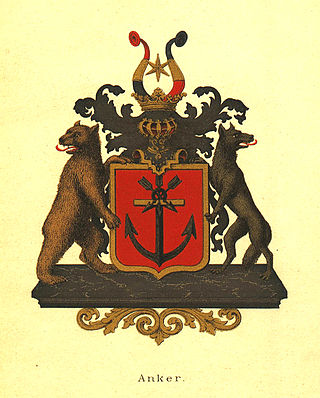
The Anker family, also spelled Ancher, is a Danish and Norwegian noble family living in Norway. The name means anchor. Originally from Sweden, the family became a part of the Patriciate of Norway in the 18th century, and members of the family were ennobled in 1778.

The Tanche family or Tank is the name of one or more Dano-Norwegian noble families of German origin. One of those lines is from Haderslev.
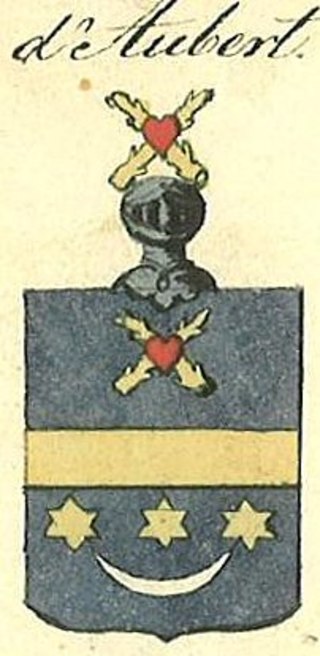
The d'Aubert family or Aubert is a family of the French nobility, and a branch belongs also to the Nobility of Denmark and to the Nobility of Norway. The family originates in the town of Thionville in Lothringen, where their progenitor Jean Aubert was a merchant. Today members live in France, in Denmark, in Norway, in Sweden, and in Germany.

Heraldic adoption was in the Kingdom of Poland a legal form of ennoblement and adoption into an existing heraldic clan along with assuming the coat of arms of that clan. It took place as a result of an act issued by the King. The adoption of heraldic arms was a procedure used solely in Polish heraldry and was one of the earlier "old way" forms of ennoblement in Poland. It became particularly popular in the 15th century, especially with prosperous or prestigious city burghers and patricians aspiring to attain noble status, but was abolished by the first half of the 17th century.
